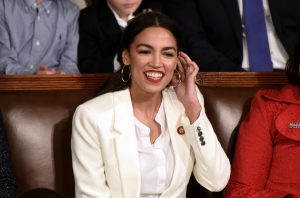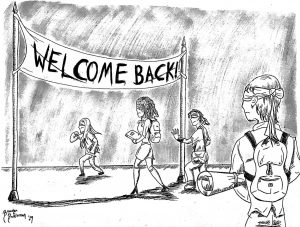Neal: Political polarization is crucially affecting the majority
There is a wedge between the two major political parties of America and that wedge is only being driven deeper. As a result, the majority of Americans are hushed and ignored, while the opposing sides grow increasingly louder and spiteful.
January 21, 2019
Because President Trump and the Democrats have yet to come to an agreement over whether to begin construction on the southern border wall, the government has been shut down since Dec. 21, 2018.
When it comes to immigration or nearly any controversial topic, there tends to be two incredibly passionate sides at opposite ends of the spectrum that are not willing to give an inch for the other.
Conservative thinkers tend to be called close-minded or deplorable by leftists, while more liberal thinkers often receive the generic branding of “snowflake.” Whether it’s defensive pride or honorable passion, many tend to cling to either side of the political horizon, resulting in a large gap full of the ignored majority.
As a liberal writer, I felt it was most appropriate to discuss this matter with an individual who is aligned with the political party whose views I oppose in order to gain more insight.
Determined to understand more about this divide, I reached out to the Republican candidate for Iowa’s 2nd Congressional District in the 2018 election, Chris Peters, who described the phenomenon of the two opposing sides becoming more distant as politics grows more polarized.
RELATED: Mahoney: A large field could bring out the radical Democrats – we’ve seen this before
The democratic United States of America consists of various parties. The two major parties that run the government are the Democratic Party and the Republican Party, and in Peters’ words, “If you want a chance of electoral success, you have to pick one.”
Because the United States is a two-party system, moderate voices are often drowned out and deprived of their power. The problem with ignoring these moderate voices is that they are the majority, according to a recent study by the organization More in Common, an international initiative that aims to help communities build resilience to social division. This study surveyed Americans nationwide and separated them into seven categories across a spectrum, ranging from “Progressive Activists” to “Devoted Conservatives.” Among these demographics, 86 percent of people are part of the “exhausted majority,” and more than a quarter of Americans consider themselves “politically disengaged.”
“Our political system is structured to go to the extremes … so we’re not only not finding the good solutions that we need by involving, engaging everybody, but our discourse is becoming even more course, and angrier, and more spiteful,” Peters said.
RELATED: Neal: The split left: preparing for 2020
Obligating candidates to take a more extreme side — even if it does not run parallel to their personal stances — is what our political system enforces, because that is what our society pays more attention to.
After asking Peters if he felt it was necessary for candidates to shift their personal views to cater to an audience, his response was, “I don’t think you have to, but if you want to be successful, you’re better off doing that.” This is why, a lot of the time, we witness politicians gradually fluctuate from the extremes to more moderate positions post-election.
However, until they are elected, politicians will more than likely feed their target audiences what they want to hear to secure the vote. This does not necessarily mean candidates will always explicitly lie; rather, candidates emphasize the appropriate stances to the appropriate audiences.
There are many organizations out there attempting to bridge the gap and increase healthy dialogue over the matter. Contributing and encouraging others to add to the conversation also combats the political polarization in our society. The more dialogue there is, the closer we are to finding a middle-ground with a solution and heading in a direction toward overall more positive rhetoric.






